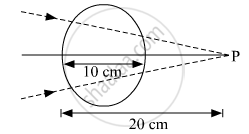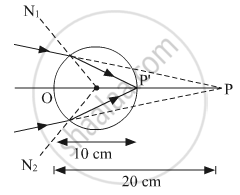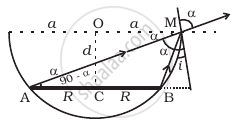Advertisements
Advertisements
प्रश्न
A converging beam of light traveling in air converges at a point P as shown in the figure. When a glass sphere of refractive index 1⋅5 is introduced in between the path of the beam, calculate the new position of, the image. Also, draw the ray diagram for the image formed.

उत्तर
For refraction at curved surfaces, using the relation, `mu_2/"v" - mu_1/"u" = (mu_2 - mu_1)/"R"` .......(1)
For the given conditions:

The first refraction takes place at the left side of the sphere. As the incident rays are going to converge at a point 20 cm away from the pole of the curved surface so,
`mu = +20 "cm", "R" =+5 "cm", mu_1 = 1, mu_2 = 1.5`
Using equation 1,
`1.5/"v" - 1/20 = (1.5 - 1)/5`
⇒ `1.5/"v" = 0.5/5 + 1/20 = 1/10 + 1/20 = 3/20`
⇒ v = 10 cm

As the image distance equal to the diameter of the glass sphere, hence the final image will form at point Q, on the circumference of the sphere, as shown in the figure.
APPEARS IN
संबंधित प्रश्न
A diver under water, looks obliquely at a fisherman standing on the bank of a lake. Would the fisherman look taller or shorter to the diver than what he actually is?
For the same value of angle of incidence, the angles of refraction in three media A, B and C are 15°, 25° and 35° respectively. In which medium would the velocity of light be minimum?
Why does a diamond shine more than a glass piece cut to the same shape?
Consider the situation in figure. The bottom of the pot is a reflecting plane mirror, S is a small fish and T is a human eye. Refractive index of water is μ. (a) At what distance(s) from itself will the fish see the image(s) of the eye? (b) At what distance(s) from itself will the eye see the image(s) of the fish.

Figure shows a transparent hemisphere of radius 3.0 cm made of a material of refractive index 2.0. (a) A narrow beam of parallel rays is incident on the hemisphere as shown in the figure. Are the rays totally reflected at the plane surface? (b) Find the image formed by the refraction at the first surface. (c) Find the image formed by the reflection or by the refraction at the plane surface. (d) Trace qualitatively the final rays as they come out of the hemisphere.

Obtain the equation for apparent depth.
Obtain the equation for lateral displacement of light passing through a glass slab.
The critical angle is maximum when light travels from ______.
`(a^mu"w"=4/3,a^mug=3/2)`
Three immiscible liquids of densities d1 > d2 > d3 and refractive indices µ1 > µ2 > µ3 are put in a beaker. The height of each liquid column is `h/3`. A dot is made at the bottom of the beaker. For near normal vision, find the apparent depth of the dot.
A circular disc of radius ‘R’ is placed co-axially and horizontally inside an opaque hemispherical bowl of radius ‘a’ (Figure). The far edge of the disc is just visible when viewed from the edge of the bowl. The bowl is filled with transparent liquid of refractive index µ and the near edge of the disc becomes just visible. How far below the top of the bowl is the disc placed?

